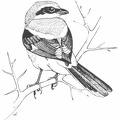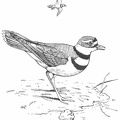House Wren
Most Americans seem to have fallen in love with the House Wren. It could not be his beauty for he lacks the distinctive markings found on other birds, even other wrens. Even in good light you see only a small grayish-brown bird with lighter underparts. It is surely not his size for he is smaller than a sparrow. His song is a sort of spontaneous outburst of notes which give you more quantity than quality, with a liberal helping of scolding notes, so it is not his vocal efforts. He is not a good bird neighbor for he often punctures the eggs of other nesting birds in his area. It must be his independence that has won him favor.
No other bird finds such an assortment of nesting boxes, all sizes, shapes and colors, some homemade, others purchased. Some he will use, while others offer no attraction. He may pass up a well-placed wren house to build in the pocket of an old coat hung in a shed. He likes boxes 8 to 10 feet above ground, not hidden by limbs.
He prefers low shrubs, piles of brush or wood, or even open spots in heavy timber, for there he finds the insects and small spiders which form the major part of his food. Most of his hunting is either on or near the ground while nesting sites are seldom above 12 feet. He runs to large families and more than one brood is reared.
- Author
- The Project Gutenberg EBook of Introduction to Our Bird Friends, Volume 1, by Lenwood Ballard Carson
Published 1954 - Posted on
- Wednesday 8 July 2020
- Dimensions
- 438*786
- Tags
- Birds
- Albums
- Visits
- 718
- Downloads
- 22
 Download Photo
Download Photo





